If you’re looking for the best ways to make chemistry fun, I recommend exploring some top board and card games designed for learners aged 8 and up. Games like Valence, Ion, and Peptide combine engaging gameplay with accurate science concepts, making learning feel like play. Whether you’re teaching middle school students or enjoying family game night, these options provide quality entertainment and education. Stick around to discover more about these exciting science-focused games.
Key Takeaways
- The list includes engaging, scientifically accurate games like Valence, Ion, and Peptide that make learning chemistry enjoyable.
- Many games combine colorful components, strategic gameplay, and educational content aligned with NGSS standards.
- Games cater to various age groups from 8 to 12+, suitable for classroom, homeschooling, and family learning environments.
- Reusable materials, game variants, and replayability ensure long-term educational and entertainment value.
- Popular choices include card drafting, set collection, and resource management mechanics that teach chemistry concepts interactively.
Valence Card Game – Science Educational Game for Kids 8-12
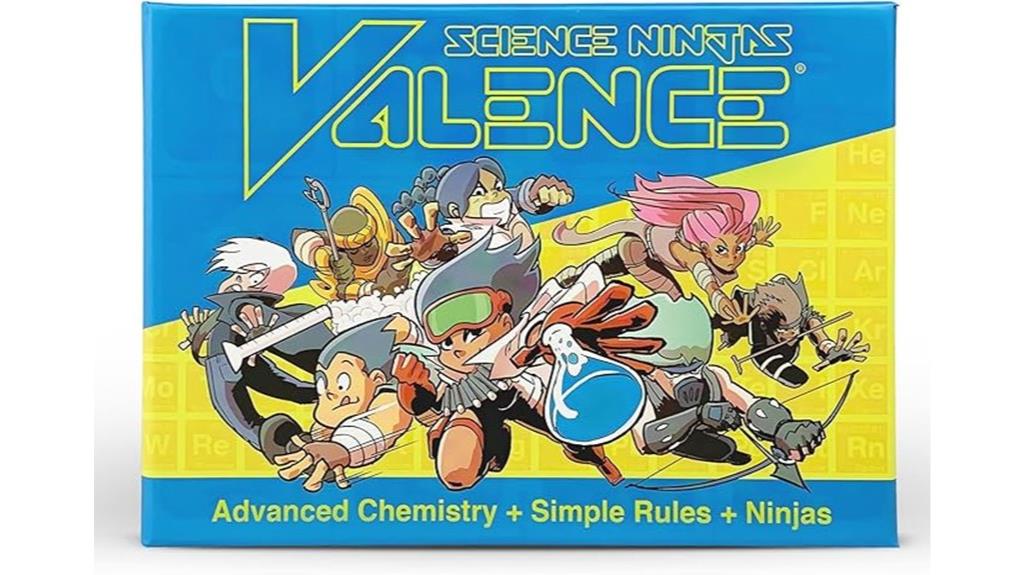
Are you looking for a fun and interactive way to introduce kids aged 8-12 to chemistry concepts? The Valence Card Game makes learning science engaging and accessible. It combines gameplay with STEM education, helping children explore the periodic table, chemical reactions, and molecular formations through colorful cards and easy rules. I love how it sparks curiosity without feeling like a chore. The game’s design promotes strategic thinking, and the visuals make complex ideas simple. Whether in the classroom, homeschooling, or family nights, Valence is a versatile tool that deepens understanding while keeping kids excited about science.
Best For: parents, teachers, and science enthusiasts looking for an engaging, educational game that introduces children aged 8-12 to chemistry concepts in a fun and accessible way.
Pros:
- Combines gameplay with STEM education, making learning chemistry enjoyable and interactive
- Features colorful illustrations and simple rules that promote strategic thinking and visual understanding of molecules and reactions
- Durable, high-quality materials designed for repeated use, suitable for classroom, homeschooling, and family settings
Cons:
- Priced higher than some comparable educational games, which may be a concern for budget-conscious buyers
- Initial complexity of rules may require additional guidance or instructional videos for full understanding
- Expansion of game modes or element variety could enhance replayability and long-term engagement
Genius Games Ion: A Compound Building Game (2nd Edition)
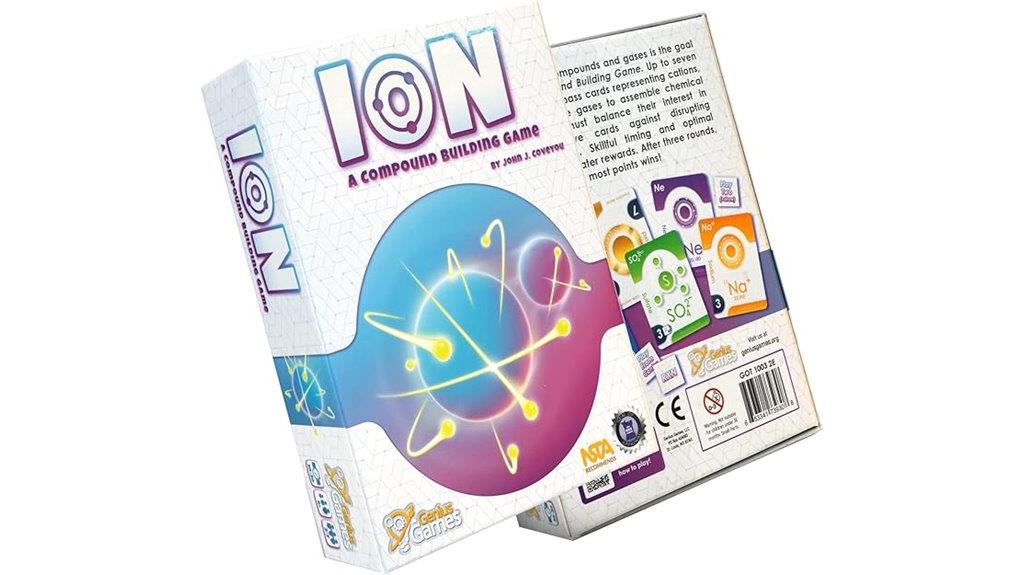
Genius Games Ion: A Compound Building Game (2nd Edition) stands out as an excellent choice for educators, homeschooling families, and science enthusiasts seeking an engaging way to teach core chemistry concepts. The game accurately covers ionic bonding, charge balancing, and noble gases, with peer-reviewed content and a helpful “Science Behind” booklet. In just 20-30 minutes, players draft cards to form compounds, matching charges and collecting noble gases. It’s easy to learn, making it perfect for younger students, yet offers advanced gameplay with radioactive decay management for experienced players. Overall, Ion combines fun and education, effectively reinforcing key chemistry ideas in a fast-paced, interactive format.
Best For: educators, homeschooling families, and science enthusiasts looking for an engaging and accurate way to teach basic and advanced chemistry concepts through a quick, fun card game.
Pros:
- Scientifically accurate and peer-reviewed content, ensuring reliable chemistry education
- Easy to learn and quick to play, suitable for a wide age range and short classroom or family sessions
- Enhances understanding of ionic bonding, charge balancing, noble gases, and introduces radioactivity for advanced learners
Cons:
- Some components and packaging quality issues reported by users, such as missing cards or accessories
- Instruction manual can be vague and confusing, especially regarding the hand-passing mechanic
- Limited complexity in the basic version, which may not satisfy more advanced or experienced players
Genius Games Peptide: Protein Building Game, Strategy Card for Gamers & Teachers

If you’re looking for an engaging way to teach or learn biology concepts, Peptide stands out as a top choice for educators, students, and science enthusiasts alike. This card game effectively teaches protein synthesis, amino acids, mRNA, and cell processes through strategic gameplay. Players build peptide chains while managing resources like ATP and organelles, making complex biology topics accessible and fun. Designed to be quick and intuitive, it’s suitable for ages 10 and up, yet offers enough depth for adults. Its scientific accuracy and classroom versatility make Peptide a valuable tool for reinforcing biology fundamentals and sparking discussions about cellular functions.
Best For: educators, students, and science enthusiasts seeking an engaging and accurate way to learn and teach biology concepts through strategic gameplay.
Pros:
- Highly educational and scientifically accurate, reinforcing key biology concepts like protein synthesis and cell processes
- Easy to learn and quick to play, suitable for ages 10 and up, making it accessible for a wide audience
- Portable and versatile, ideal for classroom, family game nights, and science clubs
Cons:
- Instructions may lack clarity, potentially causing confusion for new players
- Some game mechanics and card representations could better align with biological themes (e.g., nucleotides and RNA depiction)
- Limited complexity, which might reduce engagement for advanced biology students or adult gamers seeking deeper strategy
Periodic: A Game of the Elements Board & Card Game
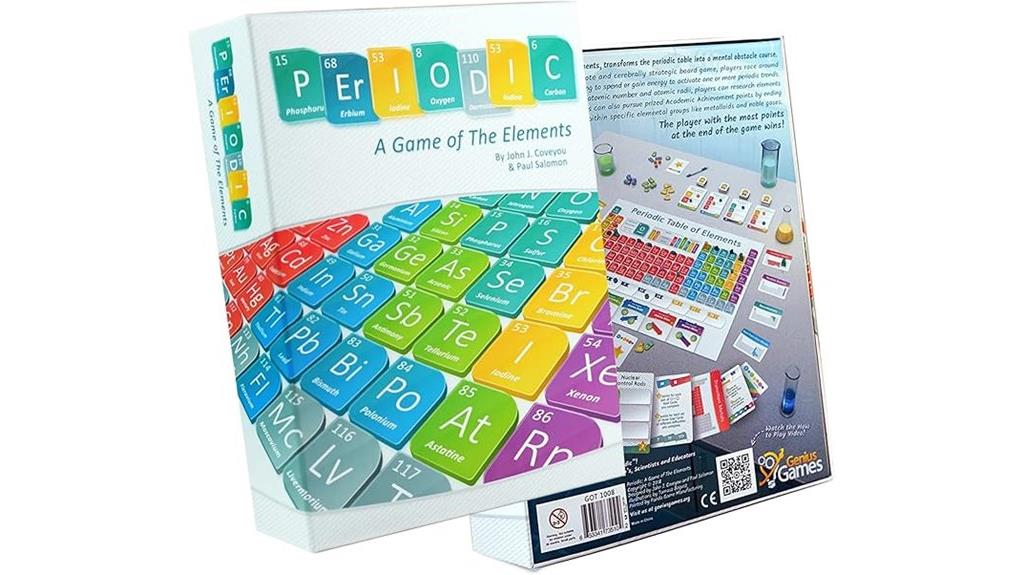
Periodic: A Game of the Elements is an excellent choice for middle school, high school, or college students and educators who want to deepen their understanding of the periodic table through engaging gameplay. This educational game covers concepts like atomic structure, periodic trends, and element groups, aligning with STEM standards and recommended by MENSA. It combines strategic movement, set collection, and resource management, encouraging tactical thinking. Suitable for ages 10 and up, it appeals to students, teachers, and science enthusiasts alike. While complex and with a steep learning curve, it offers a rewarding way to explore chemistry fundamentals and reinforce classroom lessons through fun, hands-on play.
Best For: educators, students, and science enthusiasts ages 10 and up who want an engaging and educational way to learn about the periodic table and chemistry fundamentals.
Pros:
- Combines strategic gameplay with educational content aligned to STEM standards
- Facilitates deep understanding of periodic trends, element groups, and atomic properties
- High-quality components and engaging mechanics make learning fun and interactive
Cons:
- Steep learning curve and complex rules may be challenging for beginners or younger children
- Lengthy setup and detailed instructions can require significant prep time
- The large number of parts and pieces may be overwhelming and time-consuming to organize
Genius Games Ion: A Compound Building Game (2nd Edition)
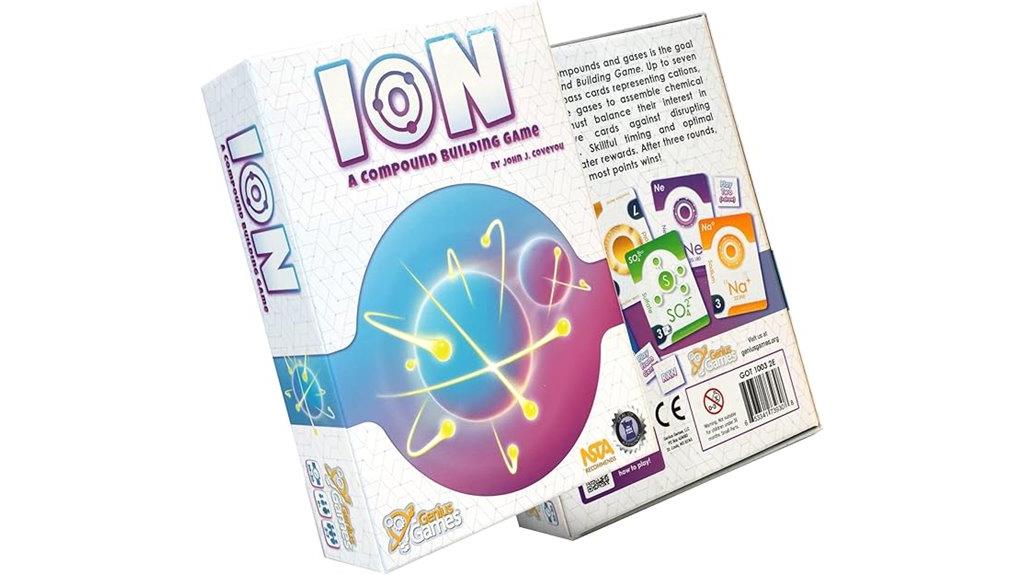
Ion: A Compound Building Game (2nd Edition) stands out as an ideal choice for educators, students, and families looking to make chemistry learning engaging and accessible. This scientifically accurate game teaches ionic bonding, balancing charges, and creating neutral compounds, all aligned with STEM and NGSS standards. It’s a fast-paced, card drafting game for 2-7 players, lasting about 20-30 minutes. Players match valence charges to form compounds, earning points for noble gases and goal cards. The advanced version introduces radioactive decay, adding complexity. Many users praise it for its fun, educational value, and quick gameplay, making chemistry concepts approachable for a wide age range.
Best For: educators, students, and families seeking an engaging, accurate, and quick chemistry learning game that aligns with STEM and NGSS standards.
Pros:
- Scientifically accurate and peer-reviewed by over 20 PhD scientists, ensuring educational reliability.
- Easy to learn with quick gameplay, making it suitable for a broad age range including children as young as 8.
- Incorporates real-world chemistry concepts like ionic bonding, noble gases, and advanced topics like radioactivity, offering both foundational and deeper learning.
Cons:
- Some users report missing cards and components, affecting the overall experience.
- The rulebook can be confusing due to vague explanations and reliance on pronouns, which may require additional clarification.
- Packaging quality and component durability have been noted as subpar by some players.
Board Games for Kids 8-12 and Family

Looking for a fun way to engage kids aged 8-12 and the whole family in science learning? “Who Knows Science Better” stands out as an ideal choice because it combines quick, interactive gameplay with a broad range of science questions. With over 500 questions covering Chemistry, Physics, and Astronomy, it offers hours of educational entertainment. The game is simple to learn, with short rounds that fit busy schedules, and it encourages friendly competition. Its portability makes it perfect for travel or family game nights. Most importantly, it makes science fun and accessible, helping players of all ages expand their knowledge effortlessly.
Best For: families, educators, and science enthusiasts looking for an engaging and educational game that makes learning about Chemistry, Physics, and Astronomy fun for kids aged 8-12 and the whole family.
Pros:
- Offers over 500 science questions, providing hours of educational entertainment
- Easy to learn with quick rounds, ideal for busy schedules and family game nights
- Portable and durable design, perfect for travel and on-the-go learning
Cons:
- Primarily multiple-choice format with limited question types, which may reduce challenge for some players
- Some reviews mention occasional quality issues like thin cardboard or minor packaging dents
- The difficulty level may need adjustment for older or more advanced science learners
Valence Plus Card Game – Science Educational Game for Kids 8-12

If you’re searching for an engaging way to introduce kids aged 8-12 to chemistry, the Valence Plus Card Game is an excellent choice. This educational game combines fun gameplay with STEM learning, featuring 166 high-quality cards that cover elements, molecules, and reactions, with a periodic table included inside. Players build compounds, explore chemical reactions, and develop strategic thinking while gaining a deeper understanding of chemistry concepts. Designed by PhD chemical engineers, the game is durable, visually appealing, and suitable for classrooms, homeschooling, or family nights. It encourages curiosity, reinforces core science principles, and makes learning chemistry enjoyable and memorable.
Best For: parents, teachers, and kids aged 8-12 seeking an engaging, educational, and hands-on way to learn chemistry concepts.
Pros:
- Combines fun gameplay with effective STEM learning, making chemistry accessible and enjoyable.
- High-quality, durable cards with vibrant artwork that enhance visual engagement and understanding.
- Versatile with multiple game variations, suitable for classrooms, homeschooling, and family game nights.
Cons:
- May require adult guidance for younger children to fully grasp some concepts.
- Advanced chemistry topics or reactions may be limited, requiring additional resources for deeper exploration.
- The physical set might be less convenient for travel compared to digital or app-based educational tools.
Subatomic: An Atom Building Game (2nd Edition)
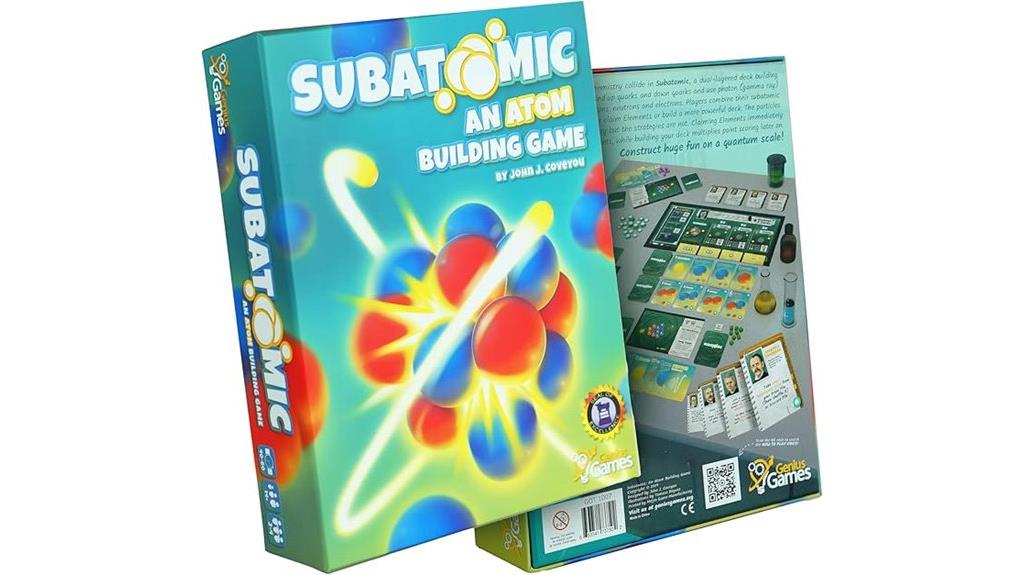
For science enthusiasts and students aged 12 and up, *Subatomic: An Atom Building Game (2nd Edition)* stands out as an engaging way to learn complex atomic concepts through strategic gameplay. This deck-building game challenges players to assemble atoms like Helium, Lithium, and Boron using real subatomic particles such as protons, neutrons, electrons, and quarks. With vibrant artwork and high-quality components, it combines science accuracy with fun mechanics—players buy cards, build atoms, and recruit famous scientists for special powers. Designed by a chemical engineer, it promotes understanding of atomic structure, making it perfect for classrooms, families, and anyone passionate about chemistry.
Best For: science enthusiasts, educators, and students aged 12+ who want an engaging and accurate way to explore atomic concepts through strategic gameplay.
Pros:
- Combines educational science content with fun, strategic deck-building mechanics
- High-quality, vibrant components and artwork enhance visual appeal and engagement
- Promotes learning of atomic structure, particles, and chemistry in an interactive format
Cons:
- Deck-building mechanics can feel slow or less dynamic for some players initially
- May be more suitable for middle school and high school students due to scientific complexity
- Limited replayability depending on deck variety and expansion options
Periodic: A Game of the Elements Board & Card Game
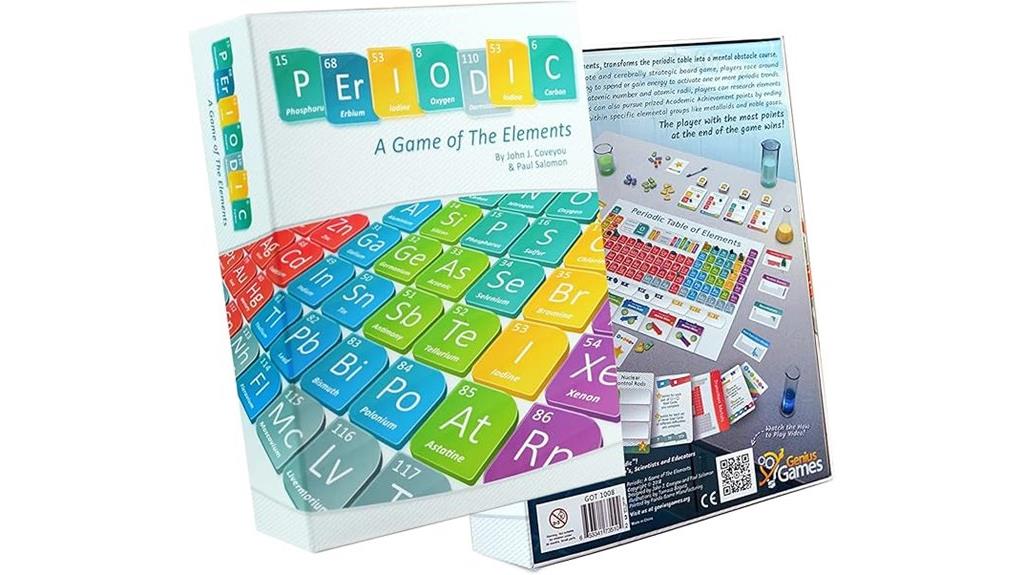
Periodic: A Game of the Elements stands out as an ideal choice for students, teachers, and science enthusiasts enthusiastic to deepen their understanding of the periodic table through engaging gameplay. This educational game covers key concepts like atomic structure, trends, and element groups, aligning with STEM standards. I appreciate how it combines strategic movement, resource management, and set collection, making it both fun and challenging. While setup can be time-consuming and the rules complex at first, the game rewards players with a deeper grasp of chemistry principles. It’s perfect for ages 10 and up, especially for those passionate about science and strategic thinking.
Best For: educators, students, and science enthusiasts who want an engaging, strategic way to learn about the periodic table and chemistry concepts.
Pros:
- Well-made components and high-quality design that enhance the gaming experience
- Effective educational content that reinforces key chemistry principles and trends
- Encourages strategic thinking, resource management, and set collection skills
Cons:
- Setup can be lengthy and time-consuming due to numerous parts and pieces
- Rules and instructions may be overwhelming or complex for beginners or casual players
- Steep learning curve initially, requiring patience and practice to master the game
Cellulose: Plant Cell Biology Game for Learning Photosynthesis & DNA
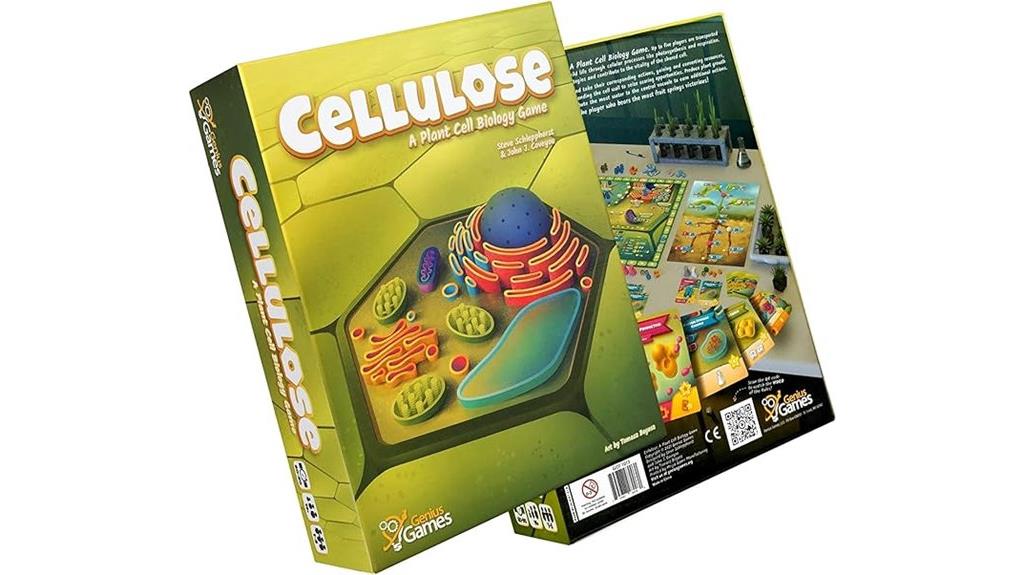
Are you searching for an engaging way to teach students or family members about plant biology and genetics? Cellulose is a plant cell biology worker placement game that makes learning about photosynthesis and DNA fun and interactive. Recommended by MENSA, it models how chloroplasts convert water and CO2 into carbohydrates, while mitochondria produce ATP. With scientifically accurate components and a detailed booklet authored by Ph.D. scientists, the game offers strategic gameplay for 1-5 players, including scenarios like water scarcity and underwater plants. It encourages resource management, strategic thinking, and understanding complex biological processes in a hands-on, accessible way that appeals to science enthusiasts and learners alike.
Best For: science educators, students, and families seeking an engaging, educational game to explore plant biology, photosynthesis, and DNA concepts through strategic gameplay.
Pros:
- Provides scientifically accurate components and detailed educational content authored by Ph.D. scientists.
- Combines entertainment with learning, making complex biological processes accessible and fun.
- Supports multiple strategies and scenarios, enhancing replayability and critical thinking skills.
Cons:
- The game’s rules and mechanics can be intricate and challenging for beginners or younger players.
- Setup may require careful attention, and the complexity might lead to initial confusion.
- Limited action spaces and shared resources can make gameplay highly competitive and potentially frustrating for some players.
The Card Game of Golf for Families, Kids, Couples, and Adults
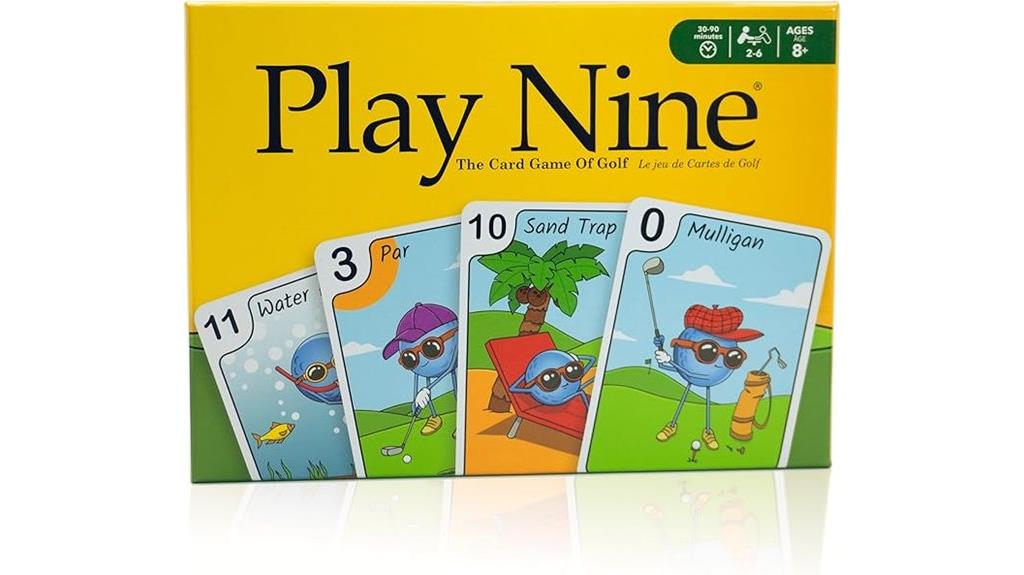
The Card Game of Golf for Families, Kids, Couples, and Adults stands out because it combines simple rules with strategic gameplay, making it accessible and engaging for players of all ages. With its golf-inspired theme, players aim for the lowest score over nine rounds, using easy-to-understand mechanics suitable for ages 8 and up. The game involves drawing, discarding, and trading cards, blending luck and strategy for a quick, fun experience. Compact and high quality, it’s perfect for family nights or casual gatherings. Its replayability and social appeal make it a favorite, encouraging friendly competition and strategic thinking in a relaxed setting.
Best For: families, kids, couples, and adults seeking an easy-to-learn, engaging card game with a golf theme for social gatherings and game nights.
Pros:
- Simple rules suitable for ages 8 and up, making it accessible to a wide audience
- Combines strategy and luck for engaging, replayable gameplay
- Compact, high-quality components ideal for portable play and storage
Cons:
- May feel too light or quick for players seeking complex or longer games
- Some players might find the randomness of luck frustrating over multiple rounds
- Limited to 2-6 players, which may not suit larger groups
Swpeet Organic Chemistry Molecular Model Kit (267 pcs)

If you’re looking for an effective tool to visualize complex organic molecules, the Swpeet Organic Chemistry Molecular Model Kit (267 pcs) is an excellent choice for students and teachers alike. It includes 116 atom pieces representing key elements like C, O, N, and H, along with 150 flexible bonds for double and triple bonds. The sturdy, food-grade plastics guarantee safety and durability, while the removable tool makes assembly easy. This kit helps make abstract molecular structures tangible, enhancing understanding of shape, bonds, and stereochemistry. Perfect for high school and university chemistry, it promotes hands-on learning and interest in science, making complex concepts much more approachable.
Best For: students and teachers seeking a durable, comprehensive molecular model kit to assist in visualizing complex organic and inorganic structures for educational purposes.
Pros:
- Includes 116 atom pieces representing key elements, enhancing variety and realism in models.
- Made from sturdy, food-grade plastics ensuring safety, durability, and long-term use.
- Comes with flexible bonds and a removable tool, facilitating easy assembly of complex molecules and double/triple bonds.
Cons:
- The lid may not stay securely closed, requiring additional solutions like rubber bands.
- Some users suggest increasing the number of certain ball types, such as four-hole balls, for greater versatility.
- The informational sheet is removable, which might lead to loss if not stored carefully.
Valence Card Game – Science Educational Game for Kids 8-12
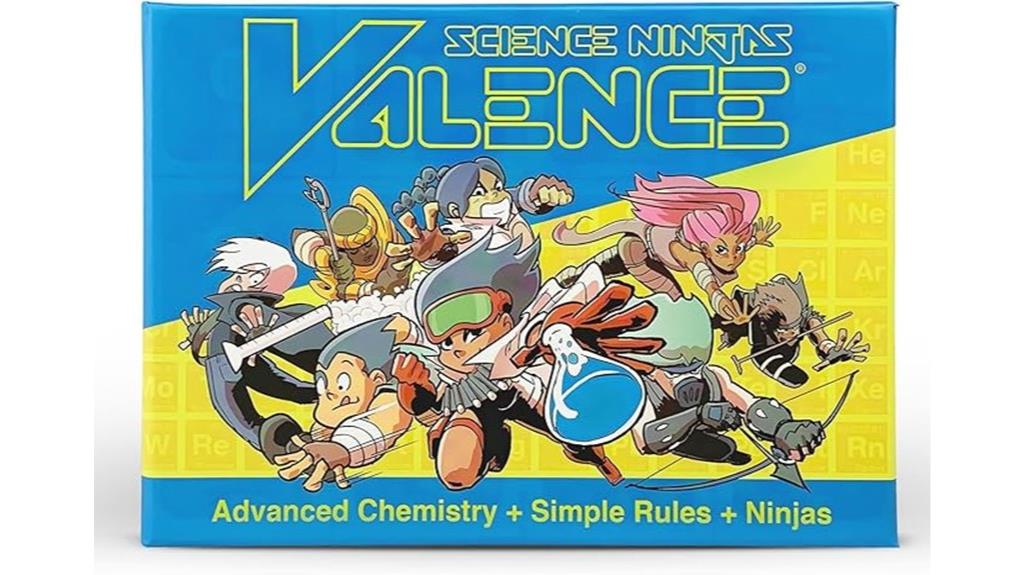
Designed specifically for kids aged 8 to 12, the Valence Card Game offers an engaging way to learn chemistry through interactive gameplay. It seamlessly combines education and fun by helping children explore the periodic table, chemical reactions, and molecular formation. The simple rules make it easy for first-time players to grasp strategies quickly, encouraging critical thinking. With colorful illustrations and hands-on mechanics, kids can visualize molecules and practice balancing charges. Ideal for classrooms, family nights, or homeschooling, the game fosters curiosity and reinforces fundamental chemistry concepts. Despite a higher price point, its durability and educational value make it a worthwhile investment for young science enthusiasts.
Best For: kids aged 8-12, educators, and families seeking a fun, educational way to explore chemistry concepts.
Pros:
- Engaging and colorful illustrations that make learning chemistry fun and accessible.
- Simple rules and instructional videos facilitate quick understanding for first-time players.
- Durable, high-quality materials designed for repeated use and long-lasting educational value.
Cons:
- Slightly higher price point compared to similar educational games, which may be a consideration for some buyers.
- Initial complexity of rules might require some guidance for younger children.
- Limited game modes initially, which could reduce replayability without expansion or customization.
Factors to Consider When Choosing Chemistry Board Games and Card Games
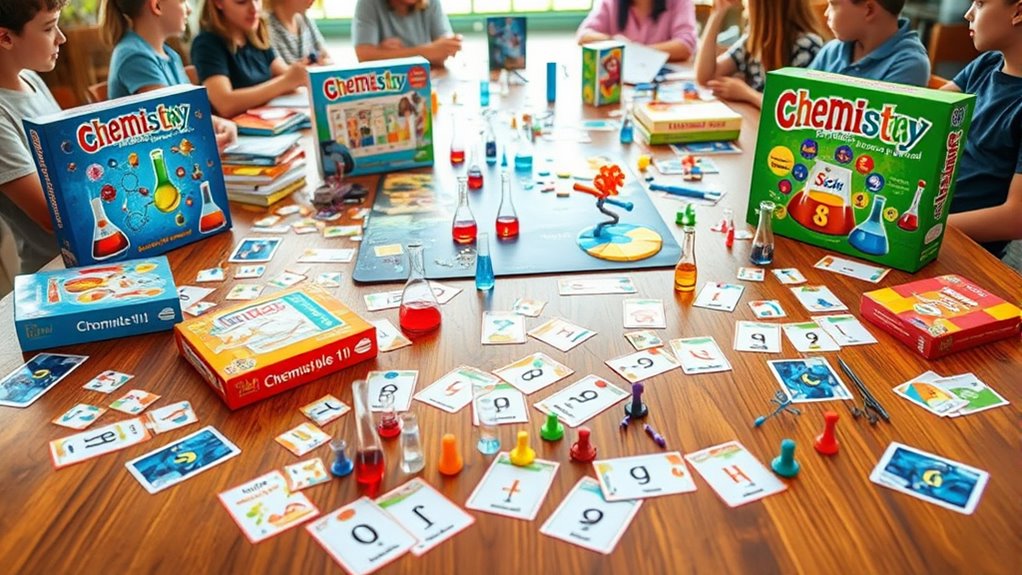
When choosing a chemistry game, I consider factors like age appropriateness to guarantee it’s suitable for the players. I also look at the educational content and gameplay complexity to balance learning with fun. Finally, I check the materials’ durability and the game’s replay potential to make a lasting, engaging choice.
Age Appropriateness
Choosing the right chemistry board or card game begins with paying close attention to the recommended age range. Ensuring the game’s suggested age matches the players’ developmental level helps promote engagement and understanding. If the rules are too complex for younger children, they might become frustrated or lose interest, so opt for simpler mechanics and visual aids that make learning accessible. For older or more advanced players, select games that incorporate more challenging concepts to keep them engaged and foster critical thinking. Additionally, choosing age-appropriate themes ensures the content is relatable and suitable. By considering these factors, you’ll find games that are not only fun but also enhance learning without overwhelming or under-stimulating your audience.
Educational Content
Selecting a game that’s both fun and educational requires paying close attention to its content. I look for games that align with established science curricula like NGSS or STEM standards, ensuring accuracy and relevance. The questions, mechanics, and themes should reinforce core concepts such as atomic structure, chemical reactions, and the periodic table. Good educational games incorporate visual aids, real-world applications, and scientific terminology to deepen understanding. I also consider whether the content has been verified by experts or peer-reviewed, which adds credibility. Ultimately, effective chemistry games stimulate curiosity, encourage discussion, and help players retain complex scientific principles through engaging, interactive play. Choosing a game with solid educational content makes learning science both meaningful and enjoyable.
Gameplay Complexity
Evaluating gameplay complexity is essential to finding a chemistry game that fits both the players’ skill levels and learning goals. I consider the age range and experience of players, since some games are simplified for young children, while others offer more advanced mechanics for older learners. Clear rules and good instructional support are vital; if rules are confusing or poorly explained, players may become frustrated or disengaged. I also look at the number of steps involved—more strategic games with many phases can be time-consuming and demanding, which might not suit casual sessions. Additionally, I assess the balance between educational content and gameplay, ensuring complexity enhances learning without overwhelming players. Finally, I consider whether rules can be expanded or customized, appealing to advanced players without complicating initial gameplay.
Material Durability
Since chemistry board and card games are often played repeatedly, prioritizing material durability is essential to guarantee they withstand frequent use. High-quality materials like thick cardboard, laminated surfaces, or laminated cards help prevent wear and tear, ensuring the game remains intact over time. Molecular model kits made from food-grade, non-hazardous plastics offer both safety and longevity, even with regular handling. Well-constructed components with reinforced edges and secure connections reduce damage, maintaining their functionality and appearance. Sturdy packaging, such as durable boxes or organizers, protects game pieces and simplifies storage, extending their lifespan. Additionally, high-quality printing with fade-resistant inks keeps visuals clear and educational details accurate after many rounds of play. Choosing durable materials guarantees your investment in learning remains fun and reliable.
Replay Potential
Durability guarantees a game can handle frequent use, but replay potential keeps the experience fresh and engaging over time. I look for games that offer multiple modes, variable rules, or expanding content, which prevents repetition and keeps gameplay exciting. Random elements like card shuffling or different starting conditions add variety, ensuring no two sessions are alike. Strategic decision-making with multiple pathways to victory encourages players to try new tactics in each playthrough. Versatile games that cater to different skill levels or allow custom rule modifications are also valuable, as they appeal to a wide range of players. Additionally, educational chemistry games with diverse questions, molecule types, or reaction scenarios provide ongoing learning opportunities, boosting replay value and making each game session uniquely rewarding.
Frequently Asked Questions
How Do These Games Align With Different Educational Curricula?
You’re wondering how these games fit into various educational curricula. I find that many chemistry games are designed to complement different teaching standards by reinforcing core concepts like atomic structure, chemical reactions, and periodic table knowledge. They’re adaptable tools that can be integrated into lessons, review sessions, or even homework, making science engaging and accessible across diverse educational levels and curricula.
Are There Multiplayer Options for Collaborative Learning?
You’re asking if these games support multiplayer options for collaborative learning. I believe they do, because many are designed for multiple players to work together, share ideas, and solve problems as a team. Collaborating, strategizing, and communicating are built right into the gameplay. This not only makes learning more engaging but also helps us develop teamwork skills, making science both fun and educational through shared discovery.
What Age Range Is Most Suitable for Each Game?
You’re wondering about the ideal age range for these educational games. I find that most chemistry-themed games are best suited for ages 8 and up, as they involve basic scientific concepts and strategic thinking. Younger children, around ages 5 to 7, can enjoy simplified versions or related games that introduce foundational ideas. It’s important to choose games that match their development level to keep learning fun and engaging.
Can These Games Be Adapted for Advanced Chemistry Topics?
This question about adapting games for advanced chemistry is like asking if a rocket can fly to the moon! Absolutely, you can crank up the complexity. I’ve seen educators add real-world research, complex formulas, and lab scenarios to make them challenging. With a little creativity, these games transform into powerful tools, engaging even the most seasoned chemistry students and turning learning into an explosive, fun adventure.
How Durable Are the Game Components for Frequent Use?
You’re wondering about the durability of game components for frequent use. From my experience, most well-made chemistry games use sturdy materials like thick cardboard, plastic pieces, and laminated cards, which hold up well over time. However, cheaper versions may wear out faster with regular play. To guarantee longevity, I recommend handling components carefully and storing them properly. Investing in quality games really pays off for long-term, frequent use.
Conclusion
So there you have it—your shortcut to turning chemistry from a snooze fest into a game night spectacle. Because who wouldn’t want to learn about ions, peptides, and elements while battling it out or building molecules? Forget boring textbooks; these games make science so fun, even your grandma might start dropping chemical formulas at dinner. Immerse yourself, play hard, and maybe, just maybe, discover your inner Einstein—without the lab coat.









